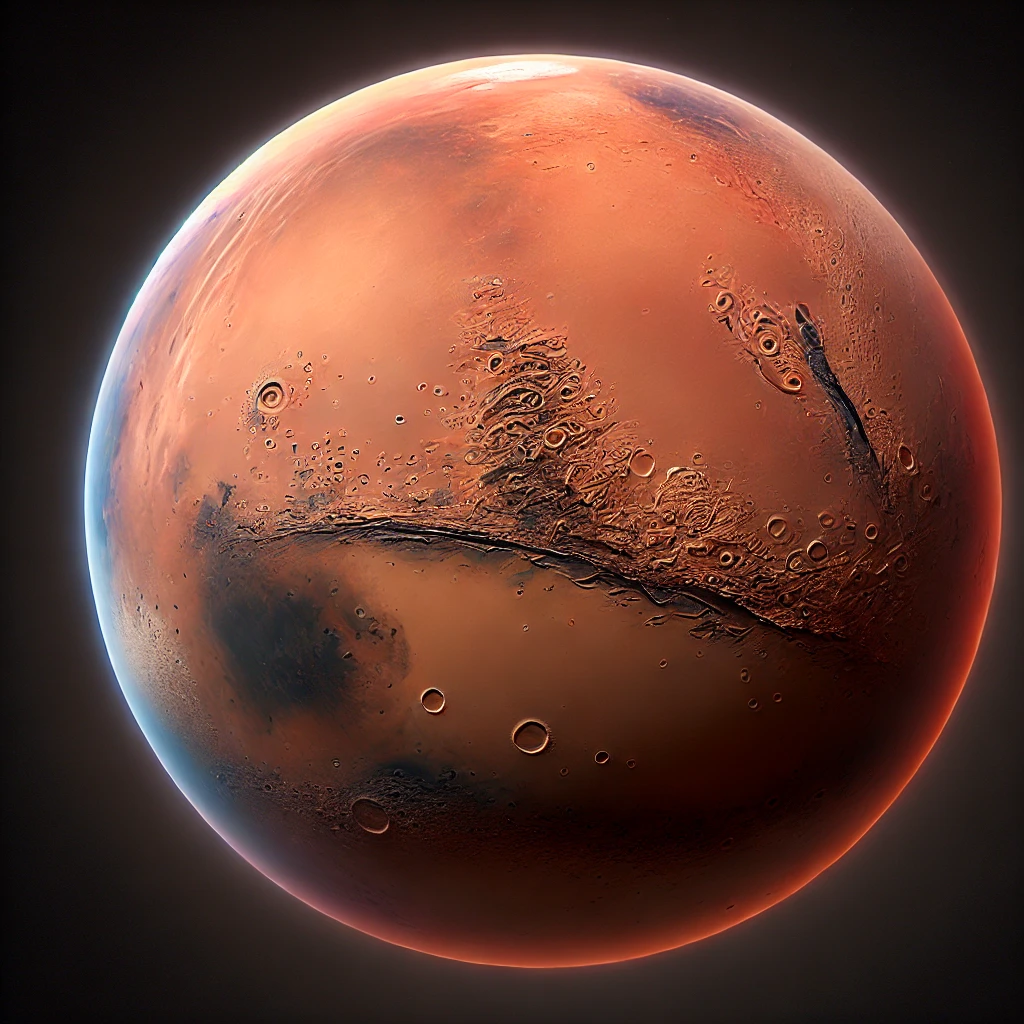Greetings, space adventurers! Captain Nova here, transmitting from the Odyssey Explorer on Day 8 of our “100 Days of Space Exploration.” Today, our journey takes us to one of the most intriguing planets in the Solar System: Mars, the Red Planet. Mars has fascinated humans for centuries with its fiery hue and mysterious features, and it continues to captivate scientists and dreamers alike. Let’s uncover the secrets of this enigmatic world.

Mars: Quick Facts
Mars, the fourth planet from the Sun, is often referred to as Earth’s “sister planet” due to some striking similarities. However, it’s also vastly different in many ways. Here are some key facts:
- Diameter: About 6,779 kilometers (4,212 miles), roughly half the size of Earth.
- Distance from the Sun: Approximately 227.9 million kilometers (141.6 million miles).
- Day Length: 24.6 hours, just a bit longer than an Earth day.
- Year Length: 687 Earth days.
- Surface Temperature: Ranges from -125°C (-195°F) at the poles to 20°C (68°F) at the equator during the day.
- Moons: Two small, irregularly shaped moons named Phobos and Deimos.
Mars’ reddish appearance is due to iron oxide, or rust, coating its surface. This gives the planet its iconic nickname and fiery look.
A Landscape of Extremes
Mars’ surface is a rugged and varied terrain, featuring:
- Vast Plains: Like the Borealis Basin, covering much of the northern hemisphere.
- Towering Volcanoes: Olympus Mons, the largest volcano in the Solar System, stands at a staggering 21.9 kilometers (13.6 miles) high—nearly three times the height of Mount Everest.
- Deep Canyons: Valles Marineris stretches over 4,000 kilometers (2,485 miles), making it 10 times longer and five times deeper than the Grand Canyon.
- Polar Ice Caps: Composed of water and dry ice (frozen carbon dioxide), these caps grow and shrink with the Martian seasons.
The Search for Life on Mars
One of the most exciting aspects of Mars exploration is the search for past or present life. While no definitive evidence of life has been found yet, scientists have uncovered tantalizing clues:
- Ancient Riverbeds: Features resembling dried-up rivers and deltas suggest that liquid water once flowed on Mars.
- Subsurface Water: Radar data indicates the presence of liquid water beneath the surface, especially near the poles.
- Organic Molecules: NASA’s Curiosity rover has detected organic compounds, which are the building blocks of life.
If life ever existed on Mars, it may have thrived billions of years ago when the planet had a thicker atmosphere and abundant water.
The Thin Martian Atmosphere
Mars’ atmosphere is about 100 times thinner than Earth’s and composed mostly of carbon dioxide (95.3%), with traces of nitrogen, argon, and oxygen. This thin atmosphere provides little protection from harmful solar radiation and extreme temperature fluctuations. However, it’s thick enough to support massive dust storms that can engulf the entire planet for weeks at a time.
Missions to Mars
Humanity’s fascination with Mars has led to numerous missions aimed at uncovering its secrets. Here are some of the most notable:
- Mariner 4 (1965): The first successful flyby, sending back 21 images of the Martian surface.
- Viking 1 and 2 (1976): These landers conducted experiments searching for signs of life.
- Mars Rovers:
- Spirit and Opportunity (2004): Explored vast distances and provided crucial insights into Martian geology.
- Curiosity (2012): Aimed at determining Mars’ habitability, it continues to operate today.
- Perseverance (2021): Equipped with advanced tools, it’s searching for signs of ancient life and collecting samples for a future return to Earth.
- Ingenuity Helicopter: Accompanying Perseverance, this small drone has achieved the first powered flight on another planet.
The Future: Humans on Mars
The idea of sending humans to Mars is no longer science fiction. NASA’s Artemis program and SpaceX’s ambitious plans are paving the way for a manned mission to the Red Planet. Establishing a permanent human presence on Mars would be a monumental step for humanity and could serve as a springboard for exploring the rest of the Solar System.
Challenges include:
- Radiation Exposure: With no magnetic field and a thin atmosphere, Mars offers little protection from cosmic rays and solar radiation.
- Life Support: Creating sustainable habitats with breathable air, drinkable water, and sufficient food will be crucial.
- Psychological Factors: The isolation and distance from Earth will require robust mental health support for astronauts.
Despite these challenges, the dream of becoming a multi-planetary species drives innovation and determination.
Mars in Culture and Mythology
Mars has been a prominent figure in human culture and mythology for millennia. The planet is named after the Roman god of war, reflecting its blood-red color. In literature and film, Mars has often been depicted as a mysterious and hostile world, from H.G. Wells’ The War of the Worlds to the more recent The Martian by Andy Weir. These stories fuel our curiosity and imagination, inspiring generations to look up at the night sky and wonder.
Why Mars Matters
Mars offers a unique window into the history and evolution of rocky planets, including Earth. By studying Mars, we gain insights into planetary processes, climate change, and the potential for life beyond our home world. Additionally, the challenges of exploring Mars push the boundaries of technology and human resilience, driving innovation that benefits life on Earth.
A World of Possibilities
As I gaze at Mars from the Odyssey Explorer, I’m struck by its stark beauty and boundless potential. The Red Planet reminds us of the power of exploration and the endless possibilities that await us in the cosmos.
Tomorrow, we’ll journey to the largest planet in our Solar System—Jupiter. Prepare to be awed by its immense size and stunning features. Until then, keep dreaming big and exploring the universe.
Stay curious,
Captain Nova
Odyssey Explorer
Leave a Reply